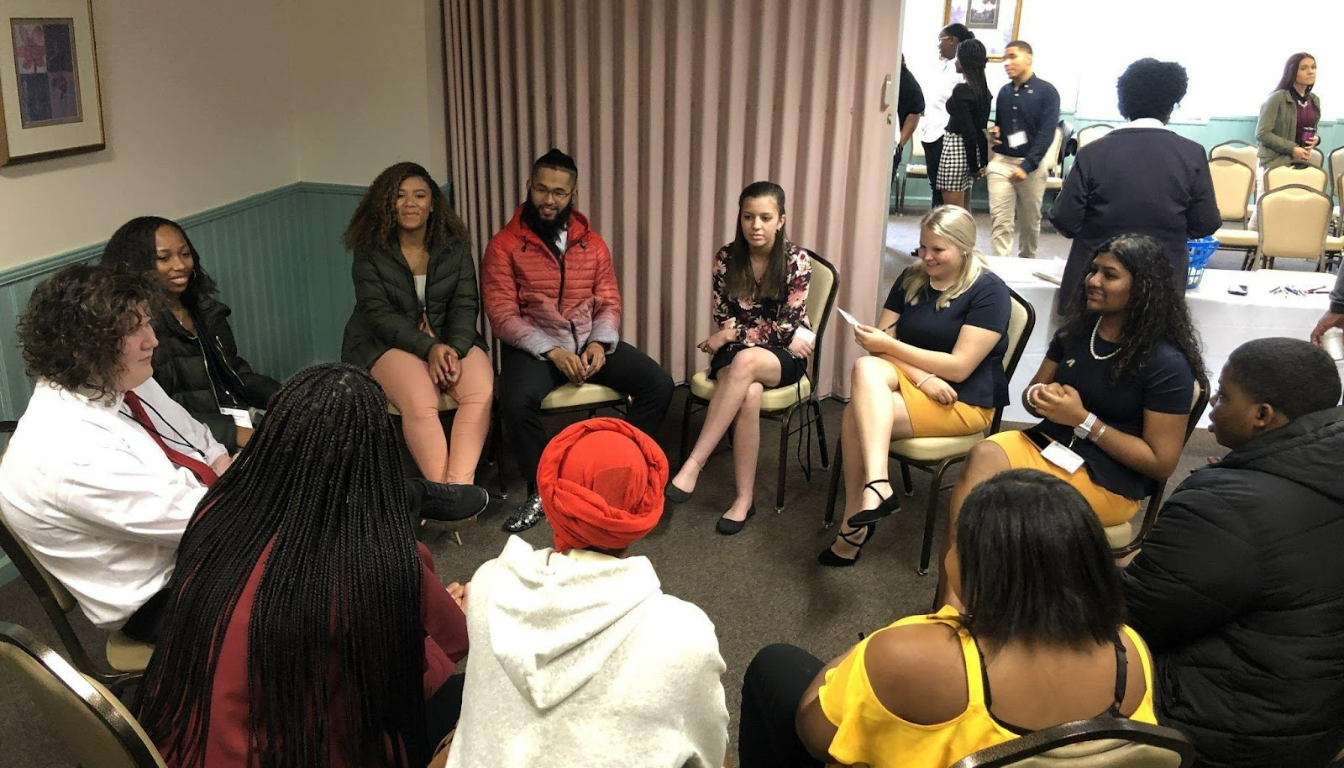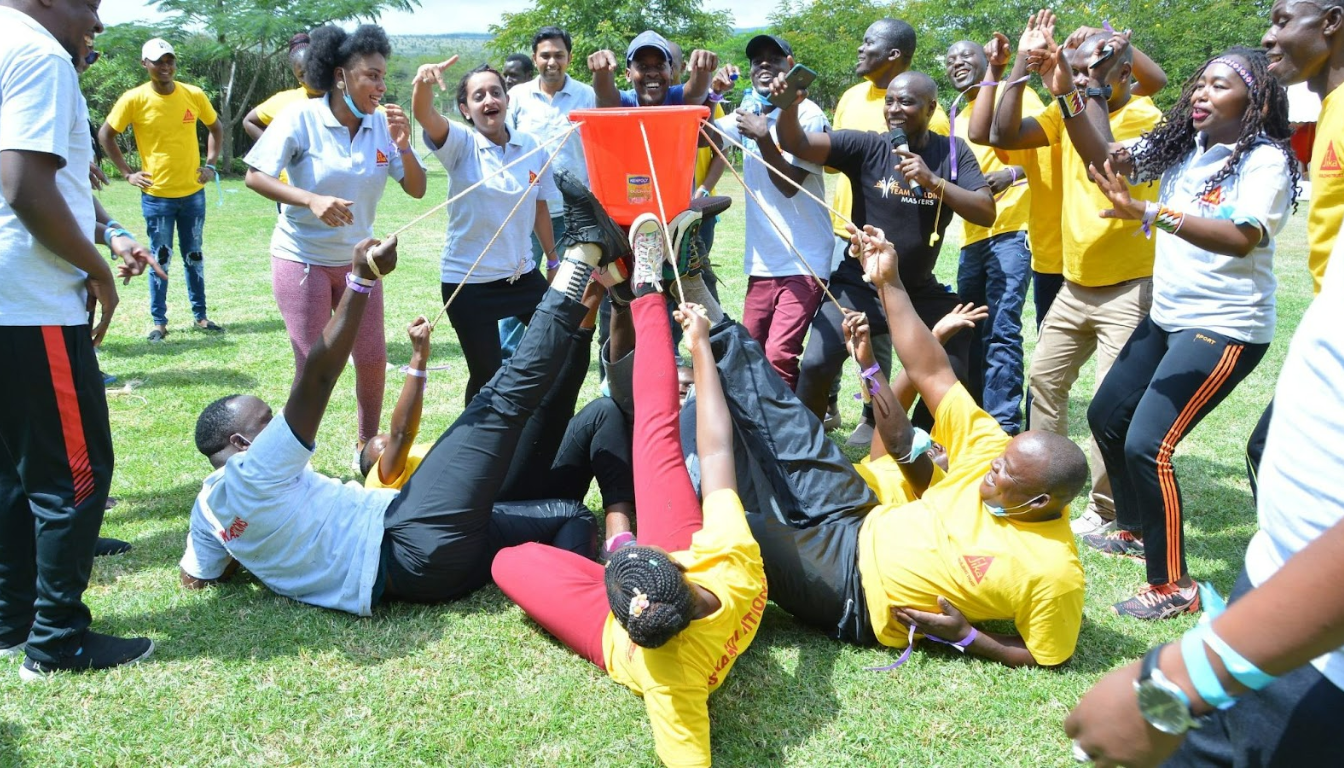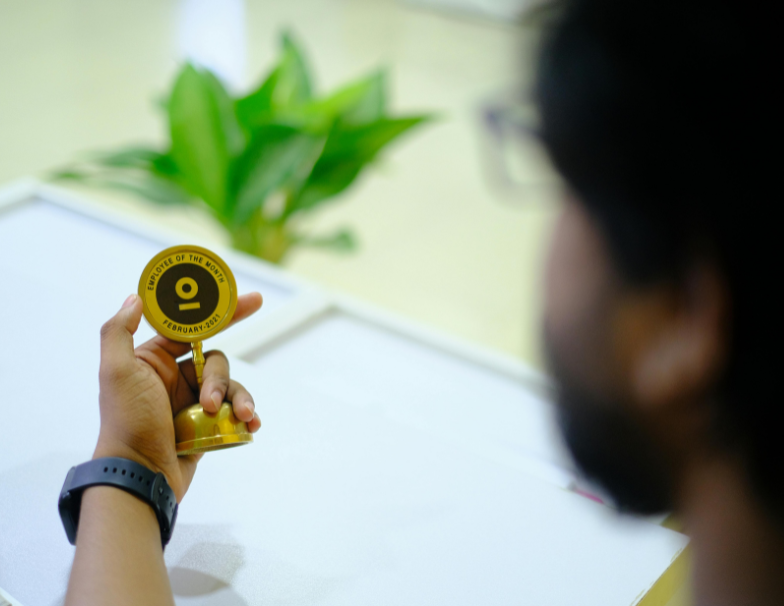23 Best Team Building and Leadership Activity to Boost Your Group's Skills

Looking to boost your team’s skills and leadership abilities? This article provides 23 top team building and leadership activities that foster communication, collaboration, and trust. Ready to elevate your team’s potential with a team building and leadership activity? Let’s dive in.
Key Takeaways
- Team building and leadership activities enhance communication, collaboration, and problem-solving skills among team members, fostering trust and camaraderie.
- Engaging in structured activities like icebreakers, collaborative problem-solving, and leadership games improves team dynamics, boosts employee satisfaction, and develops essential leadership abilities.
- Cultivating a shared understanding of core values and fostering personal growth through targeted leadership activities strengthen team cohesion and enhance overall effectiveness.
Understanding Team Building and Leadership Activities

Team building and leadership activities serve as strategic tools that unite team members and cultivate essential skills. They foster bonding and create a foundation of trust and camaraderie necessary for effective teamwork. The main goal of team building activities is to foster camaraderie and personal relationships, consequently improving communication, collaboration, and problem-solving skills within the team.
Additionally, these leadership training activities are vital for developing leadership skills and boosting overall team potential. They prepare teams to develop leadership skills for challenges by simulating real-world competition scenarios, enhancing their effectiveness.
Leaders facilitate teamwork and remove obstacles to success, highlighting the importance of a good leader, a team leader, and an effective leader in building trust, as openness creates trust and executing tasks collectively. Good leaders play a crucial role in this process.
Benefits of Team Building and Leadership Activities

Team building and leadership activities offer numerous benefits, starting with fostering trust among team members. Engaging in collaborative activities teaches employees to rely on each other, creating a foundation of trust essential for a high-performing team. This trust results in stronger collaboration and a more unified team dynamic, crucial for achieving organizational goals.
Improved communication is another key benefit. These exercises promote open dialogue and effective idea sharing, leading to better group communication and a more cohesive team. Engaging in these activities can also boost physical and mental health by promoting active participation in enjoyable tasks, contributing to overall employee satisfaction and engagement.
Team building activities can also connect remote teams, fostering a sense of community despite physical distance. This community is vital for inter-departmental interactions, helping employees understand each other’s roles and promoting a positive work culture. Regular engagement in team building activities helps organizations reinforce values, harness employee creativity, and identify potential leaders within their ranks.
Icebreaker Activities for Team Bonding
Icebreaker activities engage participants through fun, stimulating interactions, making them an excellent start for any team building session. They break down barriers and encourage bonding by creating opportunities for relaxed, informal interactions. Whether sharing personal stories or collaborating in a game, icebreakers build connections and help new team members feel welcomed and involved.
We will explore three popular icebreaker activities: “Two Truths and a Lie,” “Office Trivia,” and “What Do We Have in Common?” Each serves a unique purpose in promoting team cohesion and enhancing group communication.
Two Truths and a Lie
“Two Truths and a Lie” is a classic icebreaker that fosters familiarity and trust. Participants share two truths and one lie about themselves, while the group guesses which statement is the lie.
With a typical small group size of 5-8 people, this 30-minute activity helps team members learn interesting facts about each other as a group member in two groups, promoting active listening and engagement as a group present.
Office Trivia
Office Trivia, featuring workplace-related trivia questions, serves as an icebreaker for team building with the following characteristics:
- Accommodates groups of 5-20 people
- Lasts 30-45 minutes
- Uses familiar workplace facts and insider jokes
- Enhances team bonding and camaraderie
This exercise makes participants work together while adding a fun and competitive element to the session.
What Do We Have in Common?
“What Do We Have in Common?” promotes team cohesion by encouraging participants to discover shared interests. Team members engage in discussions to find commonalities, fostering connections and enhancing interactions.
Discovering shared interests improves team cohesion, ultimately benefiting overall performance.
Collaborative Problem-Solving Activities

Problem-solving exercises significantly enhance teamwork and innovation. These activities challenge team members to think creatively and collaborate to solve complex problems, helping teams understand each other’s thinking and build essential problem-solving skills.
We will explore three collaborative problem-solving activities: the “Marshmallow Challenge,” “Minefield,” and “The Egg Drop.” Each provides unique opportunities for teams to develop problem-solving skills and improve their ability to work together under pressure.
Marshmallow Challenge
The Marshmallow Challenge, developed by Tom Wujec, uses spaghetti sticks, tape, and string to create structures with a marshmallow on top. This 20-30 minute activity encourages teams to creatively use limited materials, promoting collaboration.
This game requires participants, strategic thinking, and teamwork, making it an excellent team-building exercise.
Minefield
The Minefield activity involves 8-16 participants, with one blindfolded member navigated through obstacles using verbal guidance from one team member. The goal is to build trust and improve communication skills.
You’ll need around 20 small objects like lunchboxes or coffee mugs as obstacles. This exercise enhances trust and hones communication skills, making it a valuable team-building activity.
The Egg Drop
In the Egg Drop activity, team members build a structure to protect a falling egg. Ideal for groups of 5-8 people, it typically takes 20-30 minutes.
The Egg Drop fosters creativity and collaboration as teams design protective structures. It requires critical thinking and cohesive teamwork to succeed.
Developing Strategic Thinking Through Leadership Games
Effective strategic thinking involves assessing trends and making long-term beneficial decisions. Leadership games focusing on strategic thinking help teams recognize opportunities and devise solutions collaboratively, introducing key leadership concepts and solving common challenges.
We will explore three leadership games that develop strategic thinking: the “Paper Tower Challenge,” “Shrinking Vessel,” and “Company Concentration.” Each requires critical and strategic thinking, enhancing leadership skills and preparing participants for real-world challenges in the leadership game.
Paper Tower Challenge
The Paper Tower Challenge involves building the tallest free-standing structure using only paper and tape. Typically involving 4-8 people per team, it lasts 20-30 minutes.
The challenge emphasizes creativity and teamwork in achieving a common goal, developing creative thinking, creative problem solving, and collaboration skills.
Shrinking Vessel
The Shrinking Vessel activity assesses team adaptability, focusing on teamwork and flexibility. It is:
- Suitable for groups of 8-10 people
- Lasting about 30 minutes
- Designed to challenge participants to adapt to a shrinking space
- Testing strategic thinking and collaboration under pressure
Company Concentration
The Company Concentration activity:
- Excites teammates for upcoming goals using cards with names, images of colleagues, and company facts.
- Is suitable for small groups of 3-6 people.
- Typically takes 20-30 minutes.
By incorporating familiar elements, this game promotes team bonding, enhances communication, and fosters unity and shared purpose.
Enhancing Communication Skills in Leadership Training

Strong communication skills are crucial for effective leadership, improving group management and collaboration. These skills are integral to successful leadership outcomes and team engagement. Participating in activities that enhance communication can significantly improve team dynamics and performance.
We will explore three activities that enhance communication skills: “Active Listening,” “Feedback: Start, Stop, Continue,” and “Trust Battery.” Each is designed to encourage participants to practice and refine their communication skills, leading to more effective leadership and collaboration.
Active Listening
Paired discussions enhance the practice of active listening among team members, fostering better communication and understanding. Structured peer coaching sessions effectively help teams practice and improve these skills.
Developing active listening skills leads to greater empathy, improved communication, and stronger team collaboration.
Feedback: Start, Stop, Continue
The “Feedback: Start, Stop, Continue” activity focuses on regular, constructive feedback. Suitable for teams familiar with feedback, it examines various aspects of a situation by polling what to start, stop, and continue.
Recommended for groups of 4 to 6 people, participants write feedback on post-its. Effective feedback should be specific, honest, and backed by evidence, fostering trust and openness.
Trust Battery
The Trust Battery activity helps participants evaluate their trust levels based on past interactions. Reflecting on experiences and discussing trust within the team builds a more trusted environment and improves overall dynamics.
Leadership Development Activities for Personal Growth
Leadership development activities encourage autonomy and initiative, particularly benefiting new leaders experimenting with various leadership styles. These activities help participants align their motivations with their leadership intentions and visualize their future achievements. By engaging in personal growth activities, leaders can develop valuable skills and promote leadership effectiveness.
In this section, we will explore three activities for personal growth: “Roles in a Meeting,” “15% Solutions,” and “The GROW Coaching Model.” Each of these activities is designed to foster personal development and improve leadership capabilities.
Roles in a Meeting
The purpose of the “Roles in a Meeting” activity is to encourage ownership and develop facilitation skills among participants. Participants are encouraged to engage actively in meetings by taking on designated roles, enhancing their leadership skills and understanding of group dynamics.
This activity is suitable for 4-30 remaining participants and typically lasts 15-30 minutes.
15% Solutions
The “15% Solutions” activity focuses on identifying immediate, manageable actions that participants can take towards their goals. By encouraging participants to think about small, actionable steps, this activity promotes a sense of progress and empowerment, aiding in personal development and leadership growth.
The GROW Coaching Model
The GROW model assists leaders in guiding discussions around goal-setting and personal development. This activity can be utilized by two or more participants and is effective in developing leadership skills and providing valuable coaching sessions.
By focusing on Goals, Reality, Options, and Will, participants can create structured plans for their personal and professional growth.
Situational Leadership Exercises
Situational leadership exercises encourage participants to adapt their styles based on the scenario at hand. These activities help leaders understand the dynamics of different leadership styles and how to apply them effectively in various situations. By engaging in a leadership exercise, teams can improve their problem-solving skills and enhance their ability to work together under different circumstances.
In this section, we will explore three situational leadership exercises: “Jumping Ship,” “Who Ya Gonna Call,” and “Ducks in a Row.” Each of these activities is designed to challenge participants to adapt their leadership styles and develop a deeper understanding of effective leadership behaviors.
Jumping Ship
“Jumping Ship” involves discussing scenarios requiring different leadership styles to help teams understand the dynamics of adaptability in leadership. By analyzing work scenarios and discussing their choices collaboratively, participants can enhance their teamwork and enrich their understanding of leadership diversity.
This team building exercise ultimately leads to improved team outcomes.
Who Ya Gonna Call
In the “Who Ya Gonna Call” activity, participants collaboratively analyze scenarios to determine effective leadership responses. This activity fosters collaborative analysis and helps teams identify the most suitable leadership styles for various situations, enhancing their problem-solving skills and leadership capabilities.
Ducks in a Row
The “Ducks in a Row” activity requires participants to outline a decision-making framework to tackle leadership challenges. Establishing a decision-making framework is crucial in leadership as it guides teams through challenging situations, ensuring structured and effective outcomes.
Group discussions following the framework enable all team members and other members to contribute their thoughts, fostering consensus and enhanced collaboration. Engaging in this group discussion activity ultimately bolsters team cohesion and improves decision-making skills among leaders.
Inspirational Leadership Activities

Inspirational leadership activities aim at developing skills to inspire team members, facilitating a stronger understanding of leadership values. Reflecting on role models and sharing personal leadership experiences helps individuals align their core values with their leadership behaviors, fostering trust and openness within teams. By engaging in these leadership building activities, teams see improved engagement, collaboration, and a deeper sense of unity among participants, enhancing their leadership qualities.
In this section, we will explore three inspirational leadership activities: “Leadership Advice from Your Role Model,” “Living Core Values,” and “Campfire.” Each of these activities is designed to inspire team members and enhance their understanding of effective leadership.
Leadership Advice from Your Role Model
The “Leadership Advice from Your Role Model” activity encourages participants to reflect on their own leadership styles and explore various leadership roles. By sharing personal leadership experiences and lessons from role models, participants can foster trust and encourage openness in teams.
Engaging in discussions on various leadership styles helps teams navigate challenging situations effectively, showcasing different leadership style approaches.
Living Core Values
The “Living Core Values” activity connects everyday behaviors with core leadership values. Participants share stories of practicing core values, which enhances the connection and trust among team members.
This activity helps team members understand and align their behaviors with the organization’s core values, leading to more effective leadership and a cohesive team culture.
Campfire
Storytelling in leadership allows leaders to convey important messages and lessons in a relatable manner, making abstract ideas more tangible. In the “Campfire” activity, leaders share personal stories that illustrate their values and vision, helping team members to understand and align with those principles.
By fostering an environment where team members feel safe to share their stories, this activity significantly enhances collaboration and group cohesion.
Leadership Activities for Setting Team Values
Leadership styles shape the culture and behaviors within an organization, making it essential to define team purpose and culture. By aligning team members on goals and work methods, organizations can achieve better focus and productivity. Reflecting on experiences and discussing how core values influence daily decisions helps teams develop a deeper understanding of their leadership philosophy.
In this section, we will explore three activities for setting team values: “Explore Your Values,” “Your Leadership Coat of Arms,” and “Team Purpose & Culture.” Each of these activities is designed to help teams identify and align their core values, fostering a more cohesive and effective team environment.
Explore Your Values
The “Explore Your Values” activity aims to reflect on personal values and prioritize them. Key details include:
- Encourages participants to identify both personal and team values through intuitive exploration of their own values
- Suitable for participants aged 13 years and older
- Takes between 60-120 minutes to complete
By choosing their top values under time constraints, participants can gain a clearer understanding of what matters most to them.
Your Leadership Coat of Arms
The “Leadership Coat of Arms” activity serves to express leadership philosophy and values. Participants should focus on the meaning of their coat of arms, considering categories such as:
- Leadership skills
- Values
- Achievements
- Work preferences
This activity typically lasts 25 minutes or more and allows participants to articulate their leadership values and important attributes based on personal achievements and work preferences during a personal event.
Team Purpose & Culture
Designing a team purpose fosters alignment among members and enhances group cohesion. By defining team values and discussing how these values influence daily decisions, participants can develop a deeper understanding of their leadership philosophy and work methods.
This activity helps teams create a unified vision and work towards shared objectives, leading to a more cohesive and effective team environment.
Summary
Team building and leadership activities play a crucial role in enhancing communication, collaboration, and problem-solving skills within teams. From icebreaker games to situational leadership exercises, each activity is designed to foster trust, improve team dynamics, and develop essential leadership skills. By regularly engaging in these activities, teams can build stronger relationships, enhance their overall performance, and create a more positive work culture.
Implementing these activities in your organization can lead to successful leadership and a high performing team. Whether you are looking to develop strategic thinking, enhance communication skills, or set team values, this guide provides a comprehensive list of activities to boost your group’s skills. Embrace these activities and watch your team grow into a cohesive, effective, and motivated unit.
FAQs
- What are team building and leadership activities, and why are they important?
Team building and leadership activities are structured exercises designed to improve communication, collaboration, trust, and problem-solving within teams. They are important because they foster stronger relationships, build essential leadership skills, and enhance overall team performance.
- How do these activities benefit organizations?
These activities help organizations by improving employee morale, strengthening communication, boosting creativity, and reinforcing company values. They also identify potential leaders and encourage teamwork across departments, which contributes to a positive work culture and higher productivity.
- What types of activities are best for building trust among team members?
Activities like “Two Truths and a Lie,” “Minefield,” and the “Trust Battery” are particularly effective for building trust. They encourage openness, active listening, and reliance on one another, which helps create a foundation of trust essential for collaboration.
- Can these activities work for both in-person and remote teams?
Yes. Many of the activities, such as Office Trivia, Feedback: Start, Stop, Continue, and the GROW Coaching Model, can be adapted for virtual environments, making them effective for remote or hybrid teams as well.
You may also like
Unique spaces for your next offsite
Find distinctive venues for your upcoming corporate retreat.
Stay Updated with Our Insights
Get exclusive content and valuable updates directly to you.







